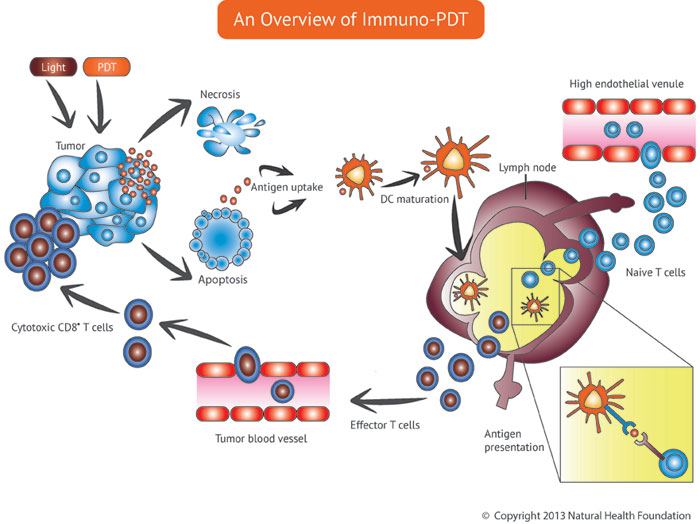The ideal cancer treatment not only targets the tumor, but also bolsters the anti-cancer immune defenses that can eliminate metastases located away from the primary tumor. To this end, we support the development of photodynamic immunotherapy strategies that address cancer at the whole body level. Physicians working in the field of cancer medicine are increasingly aware of the role of the immune system for eliminating cancer, and the development of new immunotherapy strategies has received a great deal of research attention in recent years. Nonetheless, most immunotherapy strategies seem to have limited efficacy in the context of well-established or large tumors. For this reason, combination treatments are being explored for addressing the more advanced cancers. Description: In Immuno-PDT, the anti-cancer immune defenses are activated in specific ways in order to mount an effective response against the cancer. PDT causes tumors to release antigens during the breakdown process (necrosis).The dendritic cells are able to capture the tumor antigens and then migrate to lymph nodes, where they interact with T-cells to trigger an aggressive immune response against the cancer.
Leading-Edge Research at Leiden University
Researchers at Leiden University Medical Center (LUMC) have sought to bypass the limitations of immunotherapy by combining Bremachlorin-PDT with a form of active immunotherapy known as tumor-specific peptide vaccination. The specific vaccine, called TLR ligand-conjugated peptide vaccine, can efficiently target the dendritic cells (which are pivotal to alerting the anti-cancer immune defenses) and induces a much stronger T-cell immune attack on the tumor. The LUMC researchers will test this PDT-vaccine strategy in cancer patients in a Phase I clinical study in the coming year. The goal is to combine Bremachlorin-PDT with these conjugated peptides to bolster the immune system’s activity against the tumor. In addition, the researchers will combine Bremachlorin-PDT with another immunotherapy strategy: the so-called “checkpoint blockers”. These are antibodies capable of blocking certain factors of the immune system called checkpoints, which limit the immune response against the tumor. Recent studies indicate that this combined approach can result in synergistic anti-tumor effects that may have a substantial curative impact. In the course of therapy, tumor-specific immune cells are generated that may confer long-term protection against the recurrence of tumors. These promising results indicate that Bremachlorin-PDT’s ability to remove the tumor could play a major role in cancer immunotherapy. “PDT is a promising option for robust combination therapy of advanced cancer because of its ability to target and eradicate tumors, both directly and indirectly,” says Dr. Ferry Ossendorp, one of the principal investigators of the LUMC clinical research. “Along with this direct-attack potential, PDT also has immunogenic effects that make it a uniquely suitable partner for immunotherapy.”
Harnessing Light to Eliminate Deadly Metastases
Many cancer patients have a known primary tumor as well as “silent” or hidden metastases in other organs or body locations. These metastases are thought to be responsible for the eventual demise of patients, immunotherapy represents one of the most promising ways to eliminate these metastases. If the proposed combination therapy leads to a potent anti-tumor immune response, the LUMC researchers will then analyze whether the immune system is capable of recognizing and eliminating distant tumors located in other parts of the body. Finally, by testing combination treatments in different types of cancers, the LUMC research team hopes to gain valuable knowledge as to the applicability of the therapy for specific tumor types. In collaboration with researchers from Erasmus University Medical Center in Rotterdam (The Netherlands), this innovative approach to PDT will be tried for treating malignant melanoma as well as tumors of the breast, colon, cervix and head and neck. READ MORE to learn about other photoimmune therapeutic strategies that may helpful in eliminating metastases.
A Patented Approach to Light-Based Immunotherapy
A novel therapeutic strategy for enhancing cancer therapy is the method known as Photoimmunotherapy® (PIT). Patented by one of the NHF subsidiary companies, PIT entails the use of a photosensitizer that is oxidized before being infused into the body. This unique strategy is designed to enable the immune system to better recognize and eliminate the cancer. By harnessing light in this way, the PIT strategy reprograms or retrains the immune cells so that a much stronger anti-tumor response can be orchestrated. There is preliminary evidence that the body’s tumor-killing capacities can be greatly amplified with this approach. We like to say that the PIT strategy can “Re-In-Spirit™” the immune system, thus achieving therapeutic results that surpass the more traditional forms of immunotherapy. Support us by buying The Medicine of Light as well as ebooks from the Photoimmune Discoveries eBook Series.


 English
English Français
Français Deutsch
Deutsch Nederlands
Nederlands